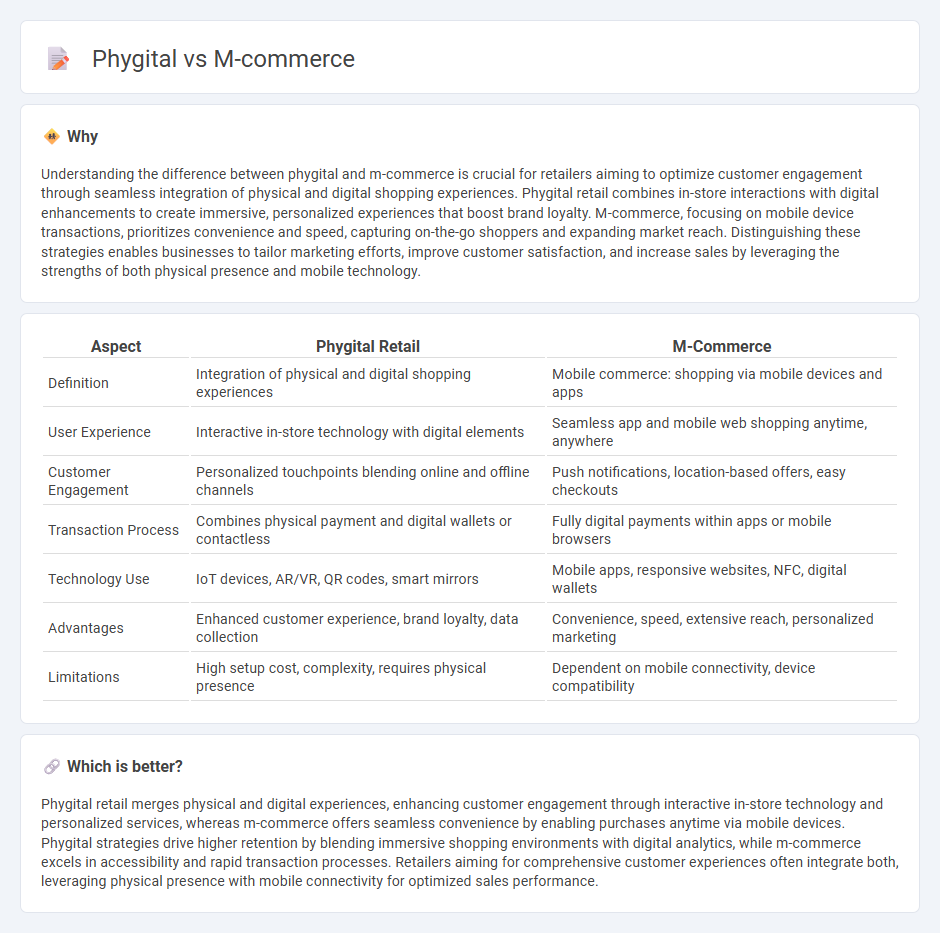
Phygital retail blends physical stores with digital technologies to create seamless, interactive shopping experiences that engage customers both online and offline. M-commerce, or mobile commerce, focuses on transactions conducted via smartphones and tablets, offering convenience and accessibility for on-the-go consumers. Explore how these innovative retail strategies are transforming consumer behavior and driving sales growth.
Why it is important
Understanding the difference between phygital and m-commerce is crucial for retailers aiming to optimize customer engagement through seamless integration of physical and digital shopping experiences. Phygital retail combines in-store interactions with digital enhancements to create immersive, personalized experiences that boost brand loyalty. M-commerce, focusing on mobile device transactions, prioritizes convenience and speed, capturing on-the-go shoppers and expanding market reach. Distinguishing these strategies enables businesses to tailor marketing efforts, improve customer satisfaction, and increase sales by leveraging the strengths of both physical presence and mobile technology.
Comparison Table
| Aspect | Phygital Retail | M-Commerce |
|---|---|---|
| Definition | Integration of physical and digital shopping experiences | Mobile commerce: shopping via mobile devices and apps |
| User Experience | Interactive in-store technology with digital elements | Seamless app and mobile web shopping anytime, anywhere |
| Customer Engagement | Personalized touchpoints blending online and offline channels | Push notifications, location-based offers, easy checkouts |
| Transaction Process | Combines physical payment and digital wallets or contactless | Fully digital payments within apps or mobile browsers |
| Technology Use | IoT devices, AR/VR, QR codes, smart mirrors | Mobile apps, responsive websites, NFC, digital wallets |
| Advantages | Enhanced customer experience, brand loyalty, data collection | Convenience, speed, extensive reach, personalized marketing |
| Limitations | High setup cost, complexity, requires physical presence | Dependent on mobile connectivity, device compatibility |
Which is better?
Phygital retail merges physical and digital experiences, enhancing customer engagement through interactive in-store technology and personalized services, whereas m-commerce offers seamless convenience by enabling purchases anytime via mobile devices. Phygital strategies drive higher retention by blending immersive shopping environments with digital analytics, while m-commerce excels in accessibility and rapid transaction processes. Retailers aiming for comprehensive customer experiences often integrate both, leveraging physical presence with mobile connectivity for optimized sales performance.
Connection
Phygital retail seamlessly integrates physical stores with mobile commerce (m-commerce) by enabling consumers to use smartphones for an enhanced shopping experience through features like QR code scanning and mobile payments. This convergence boosts customer engagement and streamlines purchase journeys by merging digital convenience with tactile in-store interactions. Retailers leveraging phygital strategies see increased sales and improved customer satisfaction by bridging online and offline channels effectively.
Key Terms
Mobile Shopping
M-commerce leverages mobile devices to enable seamless shopping experiences, integrating features like personalized recommendations and mobile payments to enhance convenience and accessibility. Phygital combines physical retail elements with digital technology, such as augmented reality and in-store mobile interactions, to create immersive and interactive shopping environments. Explore the evolving trends and strategies that define mobile shopping within both m-commerce and phygital frameworks.
Omnichannel Experience
M-commerce integrates mobile technology to enable seamless shopping via smartphones, emphasizing convenience and speed for on-the-go consumers. Phygital blends physical and digital retail environments, enhancing customer engagement through interactive in-store technologies and personalized experiences. Discover how combining m-commerce with phygital strategies elevates your omnichannel approach for maximum customer satisfaction.
In-store Technology
In-store technology in m-commerce leverages mobile devices for seamless transactions, personalized promotions, and augmented reality experiences to enhance customer engagement. Phygital retail combines digital innovations with physical store elements, integrating smart mirrors, interactive kiosks, and IoT sensors to create immersive shopping environments. Discover how these technologies redefine customer interaction and boost sales performance.
Source and External Links
What is m-commerce vs. e-commerce? - M-commerce, short for mobile commerce, involves commercial transactions conducted through apps or mobile websites, extending traditional e-commerce to mobile platforms for convenience and accessibility.
M-Commerce: Applications, Advantages & Disadvantages - M-commerce refers to buying and selling goods and services via mobile devices like smartphones and tablets, covering retail, banking, travel, entertainment, and more.
What is Mobile Commerce (M-Commerce)? - Mobile Commerce (M-Commerce) is a subset of e-commerce focused on mobile devices, enabling consumers to shop, pay, and interact with brands directly on smartphones and tablets with benefits like convenience, faster transactions, and personalization.
 dowidth.com
dowidth.com